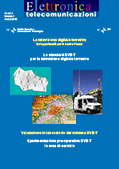 |
Cover |
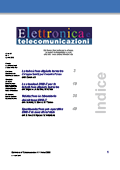 |
Contents |
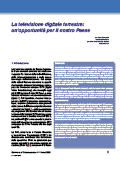 |
M. Cominetti
Digital Terrestrial Television (DTT)
“An opportunity for the Italian terrestrial broadcasting”
The European television scenario is rapidly evolving towards the adoption of digital technologies on the various media - satellite, terrestrial, cable, broadband networks - according to the standards developed by DVB (Digital Video Broadcasting).
In this context, Digital Terrestrial Television (DTT) is going to be, in the medium/long term the leading force of a mass-market capable to integrate and extend the current offer provided by satellite and cable channels, as well as to globally satisfy the different typologies of TV services - national, regional, local - and to allow DTT reception with portable and mobile terminals.
The “White Book” of the Italian Authority on Communications, the Law 66/2001 and the associated Regulations, define the new national regulatory framework and identify the main “subjects” of the new market - content provider, network operator, service provider - so establishing the conditions for the launch of DTT in Italy through an initial experimental phase.
A central role is played by the availability of commercial DTT receivers, equipped with a platform “open” to the technological evolution of new interactive and multimedia services, which is an essential condition to promote the development of a horizontal market for the benefit of the users and the operators. The DVB-MHP digital platform, fully satisfies these requirements in agreement with the guidelines of the new Directive of the European Parliament, which covers the regulatory framework of telecommunications, broadcasting and information technology.
The RAI, has already supported the Italian DTT project within the National Committee for the development of digital systems set up by the Authority on Communications, and is now prepared to extend the DTT trials in order to cover the various aspects, technological and editorial, by adopting the DVB-MHP solutions since the launching phase with aim of identifying the business models for the new services |
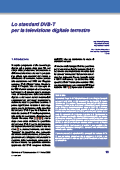 |
V. Mignone, A. Morello, M. Visintin
The European Standard for Digital Terrestrial Television (DVB-T)
The RAI Centre for Research and Technological Innovation, has directly contributed to the definition and validation of the system for digital terrestrial television broadcasting (DVB-T) in the framework of the DVB Consortium (Digital Video Broadcasting) and some European Projects: RACE dTTb, ACTS VALIDATE and MOTIVATE. The system, is based on the multicarrier COFDM technique (Coded Orthogonal Frequency Division Multiplexing) with a variety of modulation/channel coding configurations, and is characterised by two operational modes: 2K carriers for conventional multi-frequency networks (MFN), and 8K carriers for single frequency networks (SFN). These features allow fixed, portable and mobile reception.
The paper highlights the main features of the DVB-T system as well as its performance as evaluated through computer simulations, laboratory and field tests carried out by RAI-CRIT. |
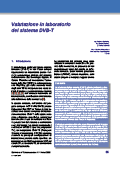 |
A. Bertella, B. Sacco, M. Tabone
DVB-T Portable Indoor Reception
The first DVB-T trials in Italy were carried out in Turin by the RAI Research Centre for Tecnological Innovation (CRIT) starting from February 1998.
The principal aim of these tests were the technical evaluation of the DVB-T system performance and the identification of the service requirements.
The present article describes the tests carried out at the CRIT premises related to the DTT portable indoor reception and the evaluation of the in-band gap-fillers used to significatively improve the reception quality in those building areas which are scarcely covered by the DVB-T service.
Technical evaluations were carried out in more than 140 receiving sites distributed within the three floors of CRIT’s building.
The effect of short//strong echoes affecting the OFDM spectrum and the indoor portable reception quality was investigated, as well as the compatibility of the gap-fillers against the electromagnetic exposure limits.
Finally, the prototype of a new space-diversity receiving antenna was developed; its technical characteristics are highlighted and the results of indoor reception are reported. |
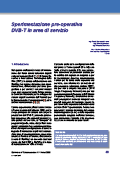 |
P. B. Forni, S. Ripamonti, V. Sardella
Experimental DTT trials in the service area
The paper reports the main results of the pre-operational DTT trials carried out in the Turin area and highlights the architecture of the DVB-T network which is being installed in the Aosta Valley and will establish, in the near future, a new RAI experimental DTT pilot area. |